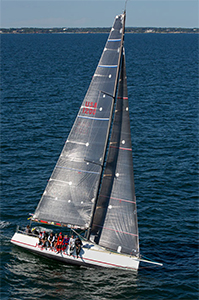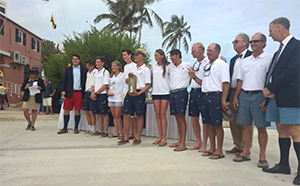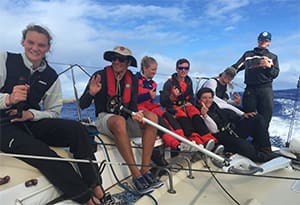To the editor: In the summer of 2016, having just turned 18, I fulfilled a dream. Not only did I compete in the biennial Newport to Bermuda Race, but I also crossed the finish line first with one of the youngest crews to ever compete in the race. I was a watch captain aboard the boat High Noon for the 635-mile offshore effort. Our team consisted of seven youth sailors, all 18 and under, and three adults. In the 100-year history of the race, few crews as young as ours have coordinated and captained their own boat.
In 2013, my sailing mentor, Peter Becker of Rye, N.Y., took the reins of the American Yacht Club Junior Racing team. From the outset, Peter’s goal was to create a team of highly skilled junior sailors capable of competing against the most experienced adult teams. We entered in as many day races and distance races as possible, against sailors of every age. Peter always joked that all our races were practice for The Big One: the Newport to Bermuda Race. I knew he was serious.
In the summer of 2013, our team of 14- to 18-year-olds won the Vineyard Race, a 238-mile race from Stamford, Conn., around the Buzzards Bay Tower and back, a victory that had never before been accomplished by a youth team. I love to sail, and our successes summer after summer only deepened my commitment to our youth team. Peter knew what our young team was capable of and had us all dreaming of racing to Bermuda.
Our first challenge was to find a fast, available boat. We were not looking for a boat whose owner wanted a couple token kids to be part of his adult crew. We wanted to charter our own boat with the kids as the crew and a few token adults. Our team got lucky with High Noon, a lively 41-foot racing sloop that needed everything either repaired or replaced. The boat’s owners, Steve and Heidi Benjamin of Stamford, were planning to donate the boat to the U.S. Merchant Marine Academy at Kings Point. However, for the five months before that, she was all ours.
We were given High Noon with all the gear in huge boxes. Every fitting had been removed before she was painted that winter. The deal was that we had to reassemble the entire boat and restore her to peak racing condition. It took us more than three months of work to move her from the winter storage shed to being race-ready — putting her back together was like doing an enormous jigsaw puzzle. We repaired and updated deck gear, waterproofed her and bolted every fitting. We got to know every inch of that boat while putting her back together. All non-essential gear was stripped in order to make High Noon as light, fast and competitive as possible. We engaged sponsors and secured in-kind donations: lightweight cookers from Jetboil, freeze-dried food from Mountain House, deck gear from Harken and 1,000 Clif Bars (how could 10 people possibly consume 1,000 Clif Bars in four days?). When we stuck the logos across our 20-foot boom, we knew we were legit.
High Noon hit the chilly waters of the Long Island Sound just in time for the annual Block Island Race on Memorial Day weekend. Teams preparing for the Bermuda Race use this 200-mile competition to test their boats, equipment and crews. This would be one of the few times we would sail as a team before going to Newport for the start.
By mid-June, the Newport sailing season was in full swing. There were hundreds of sailing teams in town; the most competitive were preparing for the main event of the summer, the Newport to Bermuda Race. Our team of teenagers and parents dedicated ourselves to preparing the boat and the crew for the big race. For a few of our sailors, it would be their first ocean sailing.
 |
|
The 41-foot sloop High Noon. |
|
Courtesy Newport/Bermuda Race |
Our team had sailed together for four years; we trusted each other with our lives. Our team chose the race crew based on merit and sea miles, and each crewmember took Safety at Sea classes.
On the Friday the Newport to Bermuda Race started, spectators lined the rocky shore and hundred of boats crowded the waters near the start line off Newport’s Castle Hill.
After three years of joking, dreaming and racing hundreds of miles up and down Long Island Sound, our team set off from Newport, a bunch of kids taking on some of the best sailors on the East Coast, some of them professionals. Despite all their beautiful and fast yachts, we felt proud to be racing a boat that we rebuilt ourselves.
My great friend Collin Alexander helmed the start while I trimmed the jib. Brooks Daley and Karina Becker ran the bow. Our pit girl, Maddy Ploch, made sure every sail came up and down flawlessly, while Hector McKemmy, Richard O’Leary and I trimmed the mainsail, jib and spinnakers. Each of us had our job and we were on it, determined not to lose a second or give any boat an opportunity to pass. The kids sailed the boat, while the adults were there for insurance purposes and to help navigate. It must be admitted that being coached by Guillermo Altadill, the world’s most intense ocean racer, raised our game, if only out of fear. His particular style of positive reinforcement involved barking, “You are pathetic,” and, “This is shit.” We pushed High Noon to her limit.
After a grueling 100 nautical miles, we gained the lead on Saturday afternoon. After our first full day at sea, we had 121 boats behind us. After another 50 nautical miles of light-air downwind sailing, we entered the Gulf Stream with a significant lead. The wind increased Saturday night to more than 20 knots. Massive 10-foot waves propelled us forward at speeds of more than 10 knots. In the fast winds and big waves, the longer, heavier boats had the advantage and stole our lead.
Crossing those big waves of the Gulf Stream under a brilliant full moon was breathtaking and unforgettable. I have always felt a profound respect of and spiritual connection to the sea. Those nights, miles from land, sailing across the vast ocean, I felt like Poseidon’s lieutenant, crossing his ocean kingdom.
 |
|
The young crewmembers of High Noon in Bermuda accepting an award. |
|
William McKeige |
Two days and 200 nautical miles into the race, a pack of seven boats battled for the lead. None of us had any chance of being crowned the overall champion, as the massive “mother of all boats” Comanche had already smashed the race record after finishing the 635-nautical-mile course in 34 hours, 42 minutes and 53 seconds. The rest of the fleet had at least two more days to go, and traditional line honors were still up for grabs.
From Saturday night through Monday afternoon, we surfed huge swells on a blast reach. The five frontrunners tangoed for the lead. We were behind two much bigger boats, Maximizer and Siren. Being the first to hit Bermuda didn’t seem possible until Monday night when the wind died.
As the wind began to lighten, our boat speed slowly dropped. We had to work harder and harder to keep the pace. With her large powerful sail and superlight hull, High Noon was built to fly in the light air. The larger heavier boats could not keep up. This was our time to pounce. Collin and I worked the boat nonstop until sunrise. He steered and I trimmed the sails. We pounded Red Bulls and danced High Noon through the spotty patches of light air. As the night passed, we watched Maximizer’s mast light slowly move from in front of us, to abeam of us, to behind us. We had regained the lead.
The last 30 nautical miles were agonizingly slow. We expected to finish early Tuesday morning, but the wind did not cooperate. Our only thoughts were on keeping that boat moving as fast as possible across the pale blue water toward Bermuda. Nobody said a word all morning. The island slowly came into view with the sunrise, the first land we had seen since Friday. We saw no boats between us and the finish line. We finessed the boat slowly downwind until — 88 hours, 27 minutes and five seconds after we started in Newport — we were the first to cross the finish line off St. Georges, Bermuda.
The Royal Bermudian Yacht Club had cleared their docks in anticipation of the fleet’s arrival. With 121 boats behind us, we were the only boat there for several hours. The drinking age in Bermuda is 18 — let’s just say we celebrated a bit. The next day we competed in and won the third part of the Onion Patch series on Bermuda’s Great Sound, where the America’s Cup races will be held.
The awards ceremonies were held at Government House a few days later. We were given books and a boatload of silver trophies by the Governor of Bermuda, and bottles of old rum from Mr. Gosling himself. The Race Committee had just created the Stephens Brothers Youth Division and Trophy, honoring Rod and Olin Stephens, who won the Bermuda Race with a young crew in 1932 aboard Dorade. We were thrilled to be the first team to receive this trophy.
The next day, as we celebrated on the beach, my classmates were graduating from Mamaroneck High School. I had decided to skip my prom and graduation ceremony in order to do the race. It was, without a doubt, the right decision.
After four summers of racing, not only did we sail in the Bermuda Race, we captured traditional line honors. Not even in our wildest dreams could we have imagined that a crew of teenagers would finish first in one of the most prestigious distance races in the world. But, then again, why not?
—William McKeige lives in Mamaroneck, N.Y.

